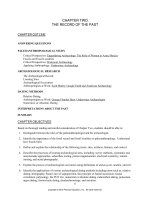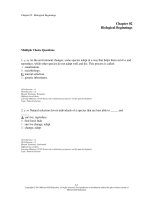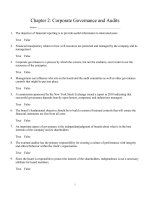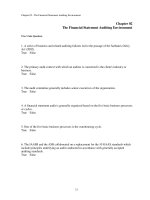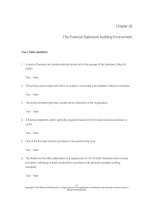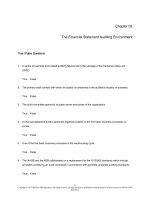Elementary statistics a step by step approach 7th edition bluman test bank
Bạn đang xem bản rút gọn của tài liệu. Xem và tải ngay bản đầy đủ của tài liệu tại đây (413.28 KB, 21 trang )
Chapter 2 - Frequency Distributions and Graphs
1. Which of the following does not need to be done when constructing a frequency
distribution?
A) select the number of classes desired
B) find the range
C) make the class width an even number
D) use classes that are mutually exclusive
Ans: C Difficulty: Easy Section: 2.1
2. The lower class limit represents the smallest data value that can be included in the class.
Ans: True Difficulty: Moderate Section: 2.1
3. When data are collected in original form, they are called __________.
Ans: raw data
Difficulty: Easy Section: 2.1
4. The __________ of a specific class is the number of data values contained in it.
Ans: frequency
Difficulty: Easy Section: 2.1
5. If a frequency distribution had class boundaries of 132.5–147.5, what would be the class
width?
Ans: 15
Difficulty: Moderate Section: 2.1
6. For the class 10 - 18, the upper class limit is
A) 9.5 B) 10 C) 18 D) 18.5
Ans: C Difficulty: Easy Section: 2.1
7. What are the boundaries of the class 12-19?
A) 11.5 and 19.5 B) 8.5 and 22.5 C) 12 and 19
Ans: A Difficulty: Easy Section: 2.1
D) 7
8. In an ungrouped frequency distribution of the average age of high school graduates, what
would be the boundaries for the class of graduates who were reported to be 18 years old?
A) 17–19 years old
C) 17.6 – 18.5 years old
B) 17.5 – 18.5 years old
D) 17.6 19.5 years old
Ans: B Difficulty: Easy Section: 2.1
9. What is the midpoint of the class 7-11 ?
A) 9.5 B) 9 C) 5 D) 4
Ans: B Difficulty: Easy Section: 2.1
Page 7
Chapter 2
10. Greg wants to construct a frequency distribution for the political affiliation of the
employees at Owen's Hardware Store. What type of distribution would be best?
A) ungrouped B) grouped C) categorical D) cumulative
Ans: C Difficulty: Easy Section: 2.1
11. What is the lower class limit of the class 13–17?
A) 15 B) 17 C) 13 D) 12.5
Ans: C Difficulty: Moderate Section: 2.1
12. What is the midpoint of the class 12–15 ?
A) 1.5 B) 13.5 C) 3 D) 13
Ans: B Difficulty: Easy Section: 2.1
13. What is the upper class boundary of the class 23–35 ?
A) 35 B) 7.5 C) 35.5 D) 7
Ans: C Difficulty: Moderate Section: 2.1
14. If the limits for a class were 20–38, the boundaries would be 19.5–38.5.
Ans: True Difficulty: Easy Section: 2.1
15. For grouped frequency distributions, the __________ is obtained by adding the lower and
upper limits and dividing by 2.
Ans: class midpoint
Difficulty: Easy Section: 2.1
16. What is the lower class limit in the class 6-10 ?
A) 6 B) 8 C) 6.5 D) 5.5
Ans: A Difficulty: Moderate Section: 2.1
17. Which of the following pairs of class limits would be appropriate for grouping the
numbers 14, 17, 12, and 19 ?
A) 11-15 and 15-19
C) 12-14 and 15-19
B) 12-14 and 17-19
D) 12-15 and 16-19
Ans: D Difficulty: Moderate Section: 2.1
18. Thirty students recorded the colors of their eyes, choosing from the colors brown, blue,
green, hazel, and black. This data can be appropriately summarized in
a(n)______________ .
A) open-ended distribution
C) grouped frequency distribution
B) categorical frequency distribution
D) upper boundary
Ans: B Difficulty: Moderate Section: 2.1
19. What are the boundaries of the class 1.87–3.43 ?
A) 1.82–3.48 B) 1.87–3.43 C) 1.879–3.439
Ans: D Difficulty: Moderate Section: 2.1
Page 8
D) 1.865–3.435
Chapter 2
20. For the class 16.3–23.8, the width is 8.5.
Ans: False Difficulty: Easy Section: 2.1
21. When the range is large, and classes that are several units in width are needed, a
__________ frequency distribution is used.
Ans: grouped
Difficulty: Moderate Section: 2.1
22. The cumulative frequency for a class is the sum of the frequencies of the classes less than
and equal to the upper boundary of the specific class.
Ans: True Difficulty: Easy Section: 2.1
23. Construct a frequency polygon from the following frequency distribution.
Temperature
Frequency
28.5–31.5
1
31.5–34.5
3
34.5–37.5
6
37.5–40.5
10
40.5–43.5
8
43.5–46.5
7
Ans:
Difficulty: Moderate
Section: 2.2
Page 9
Chapter 2
24. Find the class with the least number of data values.
A) 55-65 B) 65-75 C) 75-85 D) 85-95
Ans: D Difficulty: Easy Section: 2.2
25. Find the class with the greatest number of data values.
A) 55-65 B) 65-75 C) 75-85 D) 85-95
Ans: A Difficulty: Easy Section: 2.2
26. An ogive is also called a cumulative frequency graph.
Ans: True Difficulty: Easy Section: 2.2
27. The three most commonly used graphs in research are the histogram, the __________,
and the cumulative frequency graph (ogive).
Ans: frequency polygon
Difficulty: Easy Section: 2.2
Page 10
Chapter 2
28. Which of the following could be a cumulative frequency graph?
A)
15
10
5
0
0
5
10
15
20
B)
150
125
100
75
50
25
0
0
5
10
15
20
0
5
10
15
20
10
15
20
C)
150
125
100
75
50
25
0
D)
20
15
10
5
0
0
Ans: B
5
Difficulty: Easy
Section: 2.2
Page 11
Chapter 2
29. Which of the following could be an ogive?
A)
15
10
5
0
0
5
10
15
20
B)
150
125
100
75
50
25
0
0
5
10
15
20
0
5
10
15
20
10
15
20
C)
150
125
100
75
50
25
0
D)
20
15
10
5
0
0
Ans: B
5
Difficulty: Easy
Section: 2.2
Page 12
Chapter 2
30. Which of the following is a histogram?
A)
15
10
5
0
0
10
20
30
40
50
60
70
0
10
20
30
40
50
60
70
B)
15
10
5
0
C)
D)
Ans: D
Difficulty: Easy
Section: 2.2
Page 13
Chapter 2
31. The frequency polygon and the histogram are two different ways to represent the same
data set.
Ans: True Difficulty: Easy Section: 2.2
32. For a given data set, the ogive and the frequency polygon will have the same overall
shape.
Ans: False Difficulty: Easy Section: 2.2
33. Using the ogive shown below, what is the cumulative frequency of data values less than
or equal to 16 ?
40
30
20
10
0
6
8
10
12
14
16
18
A) 66 B) 60 C) 30 D) 20
Ans: C Difficulty: Difficult Section: 2.2
34. Graphs that show distributions using proportions instead of raw data as frequencies are
called
A) relative frequency graphs.
C) histograms.
B) ogive graphs.
D) frequency polygons.
Ans: A Difficulty: Easy Section: 2.2
35. Which type of graph represents the data by using vertical bars of various heights to
indicate frequencies?
A) ogive B) frequency polygon C) histogram D) cumulative frequency
Ans: C Difficulty: Easy Section: 2.2
36. The frequency polygon is a graph that displays the data by using lines that connect points
plotted for the frequencies at the midpoints of the classes.
Ans: True Difficulty: Easy Section: 2.2
37. A histogram is a graph that represents the cumulative frequencies for the classes in a
frequency distribution.
Ans: False Difficulty: Moderate Section: 2.2
Page 14
Chapter 2
38. Which of the following is a frequency polygon?
A)
15
10
5
0
0
10
20
30
0
10
20
30
40
50
60
70
B)
C)
15
10
5
0
40
50
60
D)
Page 15
70
Chapter 2
Ans: C
Difficulty: Moderate
Section: 2.2
39. How many values are in the data set whose histogram is shown below ?
A) 6 B) 22 C) 76 D) 72
Ans: B Difficulty: Moderate
Section: 2.2
40. Given the following frequency distribution, how many pieces of data were less than 28.5?
Class Boundaries
Frequencies
13.5–18.5
4
18.5–23.5
9
23.5–28.5
12
28.5–33.5
15
33.5–38.5
17
A) 12 B) 13 C) 25 D) 44
Ans: C Difficulty: Moderate Section: 2.2
41. If the graph of a frequency distribution has a peak and the data tapers off more slowly to
the right and more quickly to the left, the distribution is said to be ____________.
Ans: right-skewed
Difficulty: Moderate Section: 2.2
Page 16
Chapter 2
42. Construct a Pareto chart for the following distribution:
Year in School
Freshmen
Sophomores
Juniors
Seniors
Number of Students
28
14
40
18
s
or
e
So
ph
om
ni
Se
es
Fr
or
en
hm
or
ni
Ju
Difficulty: Moderate
s
45
40
35
30
25
20
15
10
5
0
s
Number of Students
Ans:
Section: 2.3
Page 17
Chapter 2
43. Construct a Pareto chart for the following distribution:
Major
Business
Science
Engineering
Social Sciences
Liberal Arts
Education
Number of Students
49
15
41
8
33
22
Ans:
Number of Students
60
50
40
30
20
10
Difficulty: Moderate
nc
e
nc
e
Sc
ie
ie
So
cia
l
Sc
on
Ed
uc
ati
lA
rts
ra
Li
be
in
g
En
gi
ne
er
Bu
sin
es
s
0
Section: 2.3
Page 18
Chapter 2
44. A local fundraiser wants to graphically display the contributions he has received over the
past five years. Construct a time series graph for the following data.
Year
Contributions
1996
$550
1997
$700
1998
$800
1999
$1050
2000
$1200
Ans:
Difficulty: Moderate
Section: 2.3
45. An automobile dealer wants to construct a pie graph to represent types of cars sold in
July. He sold 72 cars, 16 of which were convertibles. How many degrees should be used
for the convertibles section ?
A) 60° B) 80° C) 100° D) 50°
Ans: B Difficulty: Moderate Section: 2.3
46. If a data set showing types of pizza ordered at a particular restaurant indicates 24 out of
72 orders were for pepperoni pizza, how many degrees would be needed to represent
pepperoni pizza in a pie chart?
A) 90° B) 120° C) 60° D) 150°
Ans: B Difficulty: Easy Section: 2.3
Page 19
Chapter 2
47. The following information shows the colors of cars preferred by customers. Draw a pie
graph and indicate how many degrees that black represents in a pie graph?
Colors
Number
Red
50
Black
60
White
30
Green
20
Blue
40
Ans:
Difficulty: Moderate
Section: 2.3
Page 20
Chapter 2
48. Construct a pie chart for the following distribution:
Year in School
Freshmen
Sophomores
Juniors
Seniors
Number of Students
28
14
40
18
Ans:
Seniors
18%
Sophmores
14%
Juniors
40%
Difficulty: Moderate
Freshmen
28%
Section: 2.3
Page 21
Chapter 2
49. Construct a pie chart for the following distribution:
Major
Number of Students
Business
96
Science
27
Engineering
45
Social Sciences
30
Liberal Arts
36
Education
66
Ans:
Education
12%
Business
32%
Liberal Arts
22%
Social Sciences
10%
Difficulty: Difficult
Science
9%
Engineering
15%
Section: 2.3
50. Karen is constructing a pie graph to represent the number of hours her classmates do
homework each day. She found that 8 of 24 classmates did homework for three hours
each day. In her pie graph, this would represent how many degrees?
A) 135° B) 45° C) 120° D) 240°
Ans: C Difficulty: Moderate Section: 2.3
Page 22
Chapter 2
51. Construct a pie graph using the following data from a local bakery.
Cookie Types
Number Sold
Chocolate Chip
20
Peanut Butter
15
Oatmeal
30
Sugar
10
Ans:
Difficulty: Moderate
Section: 2.3
52. A Pareto chart is useful for showing percentages of the total at different times.
Ans: False Difficulty: Easy Section: 2.3
53. A weatherman records the amount of rain that fell in Portland, Oregon each day for a
year. What type of graph should he use to show how rainfall changes during the year ?
A) pie graph B) pictograph C) time series graph D) Pareto chart
Ans: C Difficulty: Easy Section: 2.3
54. What type of graph is the figure below?
A) Pareto chart B) pictograph C) ogive
Ans: A Difficulty: Easy Section: 2.3
Page 23
D) pie graph
Chapter 2
55. Graphs give a visual representation that may enable readers to analyze and interpret data
more easily than simply looking at tables of numbers.
Ans: True Difficulty: Easy Section: 2.2
56. A time series graph represents data that occur over a specific time period.
Ans: True Difficulty: Easy Section: 2.3
57. A Pareto chart does not have which of the following properties?
A) frequencies displayed by the heights of vertical bars
B) frequencies arranged from highest to lowest
C) quantitative variable on the horizontal axis
D) classes of data are categorical
Ans: C Difficulty: Easy Section: 2.3
58. A pie graph is not useful in showing which of the following characteristics of a data set?
A) frequency changes over time
B) relative frequencies for each category in the distribution
C) categories that make up the largest proportions of the total
D) categories that make up the smallest proportions of the total
Ans: A Difficulty: Easy Section: 2.3
59. A time series graph is useful for which of the following purposes?
A) representing relative frequencies of categories at a specific time
B) representing the cumulative frequencies of the data at a specific time
C) representing the frequencies of the data, sorted from largest to smallest
D) representing the changing frequencies of a data category over a period time
Ans: D Difficulty: Easy Section: 2.3
60. A time series graph is useful for detecting trends that occur over the period of time.
Ans: True Difficulty: Easy Section: 2.3
61. When making Pareto charts, data should be arranged ________________________
according to frequency.
A) from smallest to largest
C) from largest to smallest
B) with increasing time
D) clockwise
Ans: C Difficulty: Moderate Section: 2.3
62. Which graph should be used to represent the frequencies with which certain courses are
taken at Highlands Middle School?
A) Pareto chart B) time series graph C) pie graph D) pictograph
Ans: A Difficulty: Moderate Section: 2.3
63. A Pareto chart arranges data from largest to smallest according to frequencies.
Ans: True Difficulty: Easy Section: 2.3
Page 24
Chapter 2
64. When two sets of data collected over specific periods of time are compared on the same
graph using two lines, it is called a compound time series graph.
Ans: True Difficulty: Moderate Section: 2.3
65. A pie graph would best represent the number of inches of rain that has fallen in Ohio
each day for the past 2 months.
Ans: False Difficulty: Moderate Section: 2.3
66. The percentages of white, wheat, and rye bread sold at a supermarket each week is best
shown using a __________ graph.
Ans: pie
Difficulty: Moderate Section: 2.3
67. A __________ graph would most appropriately represent the number of students that
were enrolled in Statistics for each of the past ten years.
Ans: time series
Difficulty: Moderate Section: 2.3
Page 25
Chapter 2
68. Which of the following is a Pareto chart?
A)
B)
C)
D)
Ans: A
Difficulty: Easy
Section: 2.3
69. A stem and leaf plot has the advantage over a grouped frequency distribution of retaining
the actual data while still showing them in graphical form.
Ans: True Difficulty: Moderate Section: 2.3
Page 26
Chapter 2
70. Given the following two sets of data, draw a back-to-back stem and leaf plot.
A - 12, 22, 22, 24, 34, 31, 26, 35, 27, 39, 49, 10
B - 45, 36, 23, 16, 37, 28, 18, 13, 10, 23, 30, 31
Ans:
Difficulty: Moderate
Section: 2.3
Page 27


